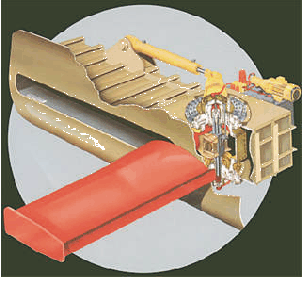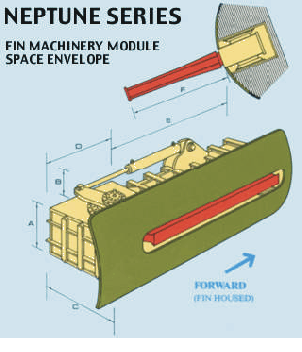2.23 Secret Modification Works in January 1994!
|
Between the 10 and 14 January 1994 the 'Estonia' was taken out of traffic and put in dry-dock at Nantali, Finland, when i.a. a pair of folding stabilizer fins were installed. The stabilizers were manufactured by Brown Brothers & Co Ltd, at Edinburgh, Scotland. One stabilizer unit is shown in the picture right. The fin folds out aft, i.e. the forward of the ship is to the left in the picture. The length of the fin was about 4,0-4,5 metres and the weight of one unit was about 15-25 tons. In order to install the stabilizers two big openings were cut in the bilge strakes of the ship hull. Actually - the openings cut in the bilge plate on each side was about 6,0-6,5 meters long and 1,5-2,0 meters high and a lot of internal structure must have been removed. Then the prefabricated boxes with the stabilizers were welded in place to internal brackets and reinforcements. Unfortunately the stabilizers are not shown on the drawings of the ship in the Final Report (5). There is no information, if the drawings of the new installation, its reinforcements and the installation work were approved and supervised by the administrations and the class. |
|
|
If the work was done by qualified welders and platers under proper conditions is also unclear. This is quite amazing. Less then nine months before the accident the 'Estonia' was modified in record time during four days in the middle of the darkest and coldest winter in an open dry-dock, and the matter is not described in any detail in the Final Report (5). The 'Erika' accident 12 December 1999 took place after major hull steel repairs had taken place and in that case the accident investigators blamed the accident on deficient repair works - in dry-dock! They actually stated that all old corroded steel was not removed and that the new steel was incorrectly welded to old steel. Thus in January 1994 big holes were cut in the highest stressed parts of the underwater body of the 'Estonia', but the Commission never investigated, if the job was properly done. Did the Class (BV) in fact approve the work? Where are the reports? Did they in fact weld the new insert plate with the stabilizer box to good, old steel? By not even mentioning the matter interested parties become curious. |
|
No Access to the Stabilizers - except via a watertight Door!
The stabilizers were installed inside a watertight compartment on deck 0 forward of the generator room. The only access to this watertight compartment was via a watertight door in the aft bulkhead or two watertight doors in the forward bulkhead. There was no direct access from deck 1 or 2. If there were a leakage inside the stabilizer compartment, you could only notice it by opening a watertight door. This arrangement was incorrect and dangerous. The reason for the new stabilizers was that the 'Estonia' had changed trade 1993 - from protected coastal traffic between Sweden and Finland to trade on the open Baltic. In the former trade fin stabilizers were not required. On the open Baltic the 'Estonia' was rolling and the passengers became seasick. Thus Estline decided to install the new stabilizers. The Final Report (5) does not contain any information, what was actually done at the last shipyard visit 1994. However, it is clear that the installation was not ready on departure 14 January 1994. Electrical and hydraulic works of the stabilizers were completed at sea. The German group of experts has tried to find out what happened at Nantali in January 1994. It seems that a fire broke out in way of the stabilizer installation works, which delayed the work. The work was later completed at sea, e.g. the electrical and hydraulic works. The Estline master Erich Moik has told the writer that he believes the accident was caused by a leakage in way of the stabilizers. At the night of the accident the stabilizers were activated - folded out - at 00.15-00.30 hrs. Soon after Sillaste 1.3 was called down to solve some 'problems'. From 21.2.3 of the German Final report:
"It is not stated what was done to rectify the problem, but Margus Treu told the English journalist Phillip Wearne in May 1998 that there had been a "stabiliser alarm" at about 00.30 hours, when the bridge tried to activate the stabilisers. It concerned the starboard fin, which did not move out and it took him and Sillaste ca. 5 minutes to activate this fin.Andi Meister told Phillip Wearne subsequently that Henrik Sillaste did not confirm the above and has refused to talk about it. Sillaste told the journalist, however, that there had been major problems with the starboard stabiliser during the installation, when the vessel had been in drydock at Naantali the last time, among other things; there had been a fire. The damage caused had to be repaired during the already very short time available and the vessel sailed as planned, however, without everything in way of the starboard stabiliser installation being carried out in accordance with good workmanship as it should have been.
In this connection two remarks have to be made:
1.) At the time of the casualty DIANA II was in the process of being taken over by N&T/ESCO in Rostock. Some Estonian crew members were already on board, also Captain Erich Moik as well as the representative of the Turku Repair Yard responsible for the installation of the stabilisers on the ESTONIA. This man had become very stressed upon hearing about the ESTONIA casualty, but then became very relaxed, when it was reported that the visor had broken off 1.46.
2.) One of the divers spoke to a member of SEA and indicated that it is known why the casualty really happened, viz. something relevant had been only "spot welded" instead of fully welded and the element could thus not withstand the forces acting on it.
During the analysis of the statements of the survivors from deck 1 the possibility that the starboard stabiliser fin broke off and tore open the empty starboard heeling tank and/or the auxiliary engine room compartment will have to be borne in mind, in particular since recent reports from Tallinn state that there had been a lot of water in the engine room, which they had been unable to pump out.
It is thus possible that, e.g. the starboard stabilizer foundation broke and ripped open the bilge strake a short distance - say 2 metres - and a 100 mm wide opening developed. Then about 100 m3/min of water could easily flow in! As the stabilizer box was installed just aft of the heeling tank, it is possible that the shell damage extended into the empty heeling tank, which thus was flooded. Result? Sudden listing!
It is possible that corrosion in the bilge strake was detected at Nantali extending forward of the stabilizer works - into the heeling tank and the sauna/pool compartment. To repair 20-30 metres of bilge strake - in addition to the stabilizer works - would have delayed the repairs by another week (and that Estline had to cancel 7-8 trips). It may be that this corrosion was made a secret condition of class - to be repaired next time (or kept under supervision)? There are no class records in the Final report (5) about the works in February 1994. The possibility of a leak in the sauna/pool compartment bilge strake is described in 2.3. It is also possible that the ship collided with the quay of the dock and buckled the visor so it didn't fit any longer.
In conclusion - the 'Estonia' was subject to big underwater hull modifications work shortly before the accident, exactly like the 'Erika' 1999, but the Commission did not bother to investigate the matter. In addition - the hull modifications work was done inside a watertight compartment that could not be inspected without opening watertight doors. In retrospect we know that the Commission had already decided - or been told - to blame the accident 1994 on visor 'design faults', which was the reason not to investigate any other possible cause. Evidently the Commission had no idea on 4 October 1994, when it first announced the false cause of accident, that the 'Estonia' had been in dry-dock 9 months earlier for major surgery in a watertight compartment that could not be accessed properly.
---

